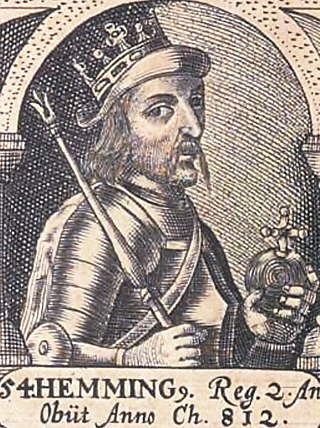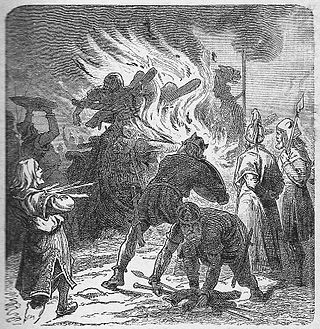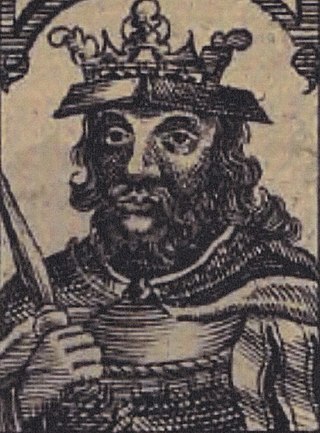
Ragnar Lodbrok, according to legends, was a Viking hero and a Swedish and Danish king. He is known from Old Norse poetry of the Viking Age, Icelandic sagas, and near-contemporary chronicles. According to traditional literature, Ragnar distinguished himself by conducting many raids against the British Isles and the Holy Roman Empire during the 9th century. He also appears in Norse legends, and according to the legendary sagas Tale of Ragnar's Sons and a Saga about Certain Ancient Kings, Ragnar Lodbrok's father has been given as the legendary king of the Swedes, Sigurd Ring.

Hemming I was a king in Denmark from 810 until his death. He was the successor of King Gudfred, his uncle.

Gudfred was a ninth century Danish king who reigned from at least 804 to 810. Alternate spellings include Godfred (Danish), Göttrick (German), Gøtrik (Danish), Gudrød (Danish), and Godofredus (Latin). He stands at the threshold of the History of Denmark in the sense that he is the first ruler about whom we have substantial knowledge from contemporary sources. He waged offensive war against the Carolingian Empire with some success, but was murdered under murky circumstances before a major confrontation had taken place. There is no unambiguous trace of Gudfred in the later Norse sagas, and his history can only be traced from the hostile Frankish texts which makes an assessment of his role problematic. His paternity is unknown but he may have been closely related to Sigfred, who preceded him as king of Denmark c. 770–804. He was the uncle of the later Danish King Hemming (810–812) and the father of King Horik I (813–854).

Sigurd Ring according to legend was a king of the Swedes, being mentioned in many old Scandinavian sagas. According to these sources he was granted rulership over Sweden as a vassal king under his uncle Harald Wartooth. Later he would take up arms against his uncle Harald in a bid to overthrow him and take the crown of Denmark, a conflict which Sigurd eventually won after the legendary Battle of the Brávellir, where it is said that Odin himself intervened and killed Harald. In the Sagas, Sigurd is also known for being the father of the Norse Viking hero and legendary king of Denmark and Sweden, Ragnar Lodbrok. According to Bósa saga ok Herrauds, there was once a saga on Sigurd Ring, but this saga is now lost.

Harald Wartooth or Harold Hiltertooth was a semi-legendary king of Denmark who is mentioned in several traditional sources. He is held to have (indirectly) succeeded his father as king of Zealand and to have expanded his realm. According to different sources, he may have ruled over Jutland, part of Sweden and the historical northern German province of Wendland. He is said to have been finally defeated and killed at the legendary Battle of Bråvalla.
Eric Anundsson or Eymundsson was a semi-legendary Swedish king who supposedly ruled during the 9th century. The Norse sagas describe him as successful in extending his realm over the Baltic Sea, but unsuccessful in his attempts of westward expansion. There is no near-contemporary evidence for his existence, the sources for his reign dating from the 13th and 14th centuries. These sources, Icelandic sagas, are generally not considered reliable sources for the periods and events they describe.

Sigurd Snake-in-the-eye or Sigurd Áslaugsson was a semi-legendary Viking warrior and Danish king active from the mid to late 9th century. According to multiple saga sources and Scandinavian histories from the 12th century and later, he is one of the sons of the legendary Viking Ragnar Lodbrok and Áslaug. His historical prototype might have been the Danish King Sigfred who ruled briefly in the 870s. Norwegian kings' genealogies of the Middle Ages name him as an ancestor of Harald Fairhair and used his mother's supposed ancestry the Völsung to create an ancestry between Harald and his descendants and Odin.
The Battle of Lena occurred on 31 January 1208 and probably took place near Kungslena, in the Tidaholm Municipality in Västergötland, Sweden. It was an important battle between the Danish-backed King Sverker II of Sweden and Prince Eric. Eric's forces won a crushing victory; however, in July 1210, Sverker returned with a second army and was killed in the Battle of Gestilren.
Olof was a king who, according to a late source, ruled in Denmark in about 900 after usurping power. Evidence for his historicity is only circumstantial, since he belongs to a period of Danish history when very little is known from textual sources.
Harald 'Klak' Halfdansson was a king in Jutland around 812–814 and again from 819–827.

Sigfred was an eighth century Danish king who is known to have reigned from before 777 to after 798. Fragments of his reign can be traced via Frankish sources.

Horik I or Hårik was a king of the Danes. He was co-ruler from 813, and sole king from c. 828 until his violent death in 854. His long and eventful reign was marked by Danish raids on the Carolingian Empire of Louis the Pious, son and successor of Charlemagne.
Gyda Anundsdotter of Sweden, also known as Guda and Gunhild, was a medieval and Viking Age Swedish princess and Danish queen consort, spouse of King Sweyn II of Denmark.

Horik II, also known as Hårik or, in late sources, Erik Barn, was King of the Danes from the fall of Horik I in 854 to an unknown date between 864 and 873. During his reign the Danish kingdom showed tendencies of breaking up. After his demise under unknown circumstances, Denmark entered a long period of obscurity, until the rise of the Jelling dynasty in the 10th century.
Halfdan was a leading person among the Danes and the first known Scandinavian to enter Frankish service. Onomastics links him to the Danish royal family since the name "Halfdan" was commonly employed both historically and in the legendary royal lineage.
Reginfrid was a co-King of Denmark from 812, when Hemming I died, to 813, when he and his brothers were ousted by the sons of a previous king, Gudfred. He was probably a son of Halfdan, a Danish leader who became a vassal of Charlemagne in 807, and brother of Anulo, Hemming, and Harald Klak. He was probably also related to the Danish king he succeeded.
Sigfred and Halfdan were two brothers who figured as Kings of the Danes in 873. Little is known about them; they are the last Danish rulers recorded by contemporary sources before the 930s.

Sigfred was a competitor for the Danish throne in 812. His brief appearance inaugurated a period of throne struggles in Denmark which lasted until 827.










